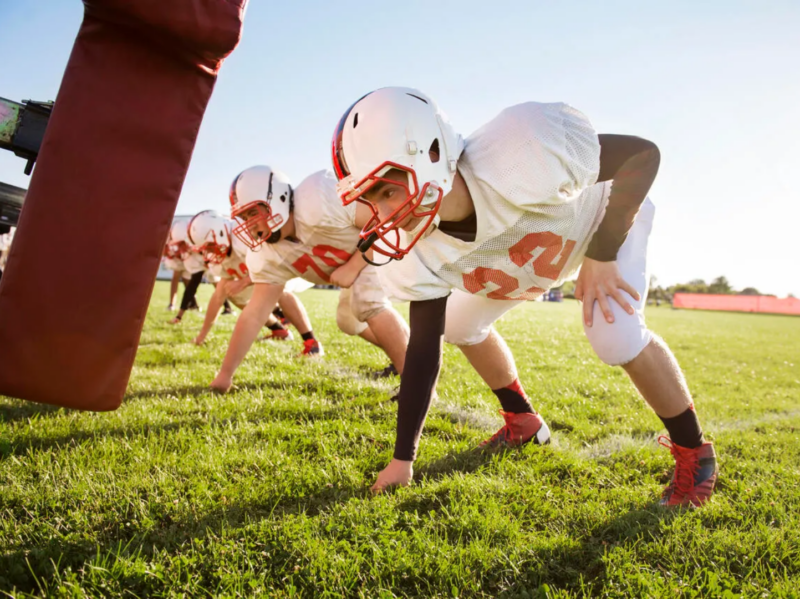Harrisburg, South Dakota, is the site of a cutting-edge pilot study that could result in making the game of football safer.
“What we’re doing is really cool and it’s unique throughout the United States,” said Thayne Munce, Ph.D., athletic health and performance scientist at Sanford Research in Sioux Falls. “Harrisburg High School is the only place where we’re conducting this type of research study.”
Sanford Health has partnered with the Harrisburg High School football team to take part in the Smart Team Project, which is funded by FieldTurf, an artificial turf company.
“This high tech, high level, sports science project is going on right here in our backyard that could inform health and safety guidelines and practices throughout the entire country,” Dr. Munce said. “It’s really rewarding to be a part of and I’m really thankful for that opportunity.”
GPS tracking for player movement
The Smart Team Project Study includes GPS tracking, where a total of 35 players for the Tigers are wearing vests that include a GPS tracker. The vests are tracking player movement on the field during games and practices.
“We can look at metrics, such as distance, speed, some composite measurements of workload that combines how fast and how far the players are running,” Dr. Munce said. “We can break that down into hard running efforts, and sprint efforts.”
A key way in which the coaching staff for the Tigers uses the intel gathered by the GPS devices is managing the workload of the high-volume players. This means limiting the number of reps the starters get at practice throughout the the week to help keep them fresh for game day. While the reps may be limited, it’s important that those practice reps mirror the pace of game speed.
“In games, players are typically sprinting more and have more of these high intensity efforts, and research has shown us that you need to expose players to that early in the week in practice,” Dr. Munce said. “If you have really light practices and suddenly you have a spike in activity, that’s when injuries occur. They need to have some of that exposure in practice to get their body accustomed to seeing those loads.”
Measuring where feet meet turf

Photo by David Brown, Sanford Health
GPS tracking is nothing new to the sport of football. What is new – and what makes the Smart Team Project study in Harrisburg unique – is the instrumented insoles that 10 members of the Harrisburg football team are wearing.
“They are called IMUs – inertial measurement units – that have accelerometers in them,” Dr. Munce said. “The IMUs are on little cards, or pods, that are placed in a standard insole that fits into your shoe. They feel like any other insole.”
These insoles are measuring data every time the player’s foot contacts the ground. It’s measuring contact force, how a player pushes off or accelerates, the symmetry from one foot to the other and the hardness of the field surface.
“This is of interest because the overarching goal of the study is to try and understand how field surfaces influence athletic performance and injury risk,” Dr. Munce said. “Bringing a wearable down to the shoe, where you get that interface with the surface, we think may give us some unique information that we’re not getting from the GPS devices.”
One step toward injury prevention
Dr. Munce and his team don’t expect to make any grand discoveries during the first year of this study. What they have learned is that doing this high-tech athletic performance study is feasible at the high school level.
“If we replicate this over multiple sites, over multiple years, we’re going to collect enough injury events that we may start to weed out some of those factors that are related to an increased risk of injury,” Dr. Munce said. “That will inform us as to if it’s specific workload management issues, if it’s asymmetry issues with players, maybe they have an imbalance in strength. If it’s poor field conditions that are contributing to the injury.”
The ultimate goal of this pilot study is injury prevention and understanding how field surfaces impact athletic performance. The first year of this study is a small piece of a much larger puzzle that could ultimately help make the game of football safer for future generations.
“We don’t expect to solve all the mysteries of injuries this year,” Dr. Munce said. “But we’re making inroads and taking a key step that will take us down that pathway that could lead to those big, exciting discoveries.”
Learn more
- Sanford study shows fewer head impacts in youth football
- Harrisburg clinic offers local care, pharmacy partnership
- Sports medicine team helps field a healthy SDSU roster
…
Posted In Orthopedics, Research, Sanford Sports, Sports Medicine
